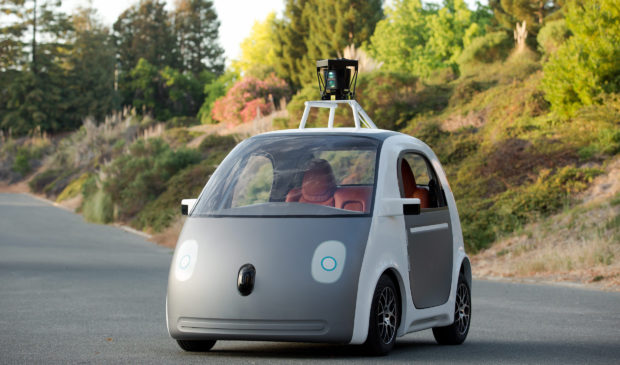Smart Mobility Roadmap draft begins its tour of boards and commissions
Friday, December 1, 2017 by
Caleb Pritchard Two of the human minds behind Austin’s robot car roadmap rolled into City Council chambers on Wednesday evening to show the fruits of their work to the city’s Joint Sustainability Committee.
Karla Taylor, Austin Transportation Department chief of staff, and Karl Popham, Austin Energy’s manager of electric vehicles and emerging technology, showcased the draft document that Taylor said outlines short-term policy prescriptions.
“Because as the technologies change so fast, we really think that this is maybe a roadmap for an up to five- or seven-year plan and not really beyond that,” she explained.
Technically known as the Smart Mobility Roadmap, the draft was released in early October, eight months after Council originally commissioned it in March.
Its purpose is to chart a path through the fog of time and carry the city to a day when the transportation system is built to accommodate shared, electric, autonomous vehicles. Council directed the drafting of the roadmap to consider reducing emissions, enhancing on-demand mobility, broadening accessibility, increasing affordability and – of course – reducing congestion.
Taylor, the roadmap’s primary cartographer, underscored the fact that autonomous vehicles alone won’t help with the latter.
“The technology doesn’t change geometry. Forty human-driven cars takes up about the same amount of space as forty self-driving cars,” Taylor told the committee.
Furthermore, autonomous vehicles will increase mobility options for people who currently cannot drive. Taylor said that vehicle miles traveled, an indicator of congestion, would increase by 14 percent if seniors, the disabled and people without driver’s licenses were able to hit the road today.
To that end, the roadmap prioritizes the concept of shared mobility wherein vehicles are not owned by individual operators and intended solely for personal use. Currently, that covers everything from Austin B-cycle, taxis and private offerings such as Lyft Line and Chariot.
In the urban core, those services would act as feeders for more conventional systems.
“We believe that high-capacity mass transit, whether it’s rail or bus rapid transit, still is the most cost-effective means to move the most amount of people in dense areas, especially during peak hours,” Taylor conceded.
The key, she said, is to make it more convenient and cost-effective for a resident to choose shared mobility options over driving alone. The roadmap recommends the creation of a comprehensive Shared-Use Mobility Plan in pursuance of that goal.
The roadmap also outlines the need to prepare for the electrification of vehicles. Investments in infrastructure such as charging stations are recommended, as well as free parking as an incentive for electric vehicle ownership.
The role of incentives when it comes to luring people into battery-powered cars could become more urgent in the future. According to a recent Citylab article, the U.S. House of Representatives in its version of the tax code overhaul bill currently lurching through Congress voted to rescind the federal electric vehicle tax credit. If the Senate follows suit, consumers will lose out on as much as a $7,500 reimbursement for the purchase of an electric vehicle.
That could potentially cool the fledgling electric vehicle industry, according to the article.
Popham brushed off those concerns, telling the Austin Monitor that a coalition of electric vehicle supporters, including powerful industry stakeholders, could pressure the Senate to keep the tax credit. In any case, he said, global demand in Europe and China is sufficient enough for automakers to continue developing the technology to one day make battery-powered cars as affordable as their petroleum-based predecessors.
“Maybe the U.S. is starting to be a little less attractive potentially if some laws were changed, but when you look at what the car manufacturers are doing and how time is on our side from a cost/parity perspective, I’ll think we’ll be fine,” said Popham.
After Taylor and Popham’s presentation, committee members sought more information about emissions goals and timelines. One part of the discussion, however, stuck out for Committee Member Francoise Luca.
She referred to Taylor’s conjecture that robot cars could be programmed to find parking on residential streets when not in use.
“I think you’d have several neighborhoods up here talking to us if we allowed them to just park in the neighborhoods,” Luca said.
The city is currently taking public input on the draft roadmap here.
The original headline of this article inaccurately stated the name of the Smart Mobility Roadmap as the Shared Mobility Roadmap. Photo by smoothgroover22 made available through a Creative Commons license.
The Austin Monitor’s work is made possible by donations from the community. Though our reporting covers donors from time to time, we are careful to keep business and editorial efforts separate while maintaining transparency. A complete list of donors is available here, and our code of ethics is explained here.
You're a community leader
And we’re honored you look to us for serious, in-depth news. You know a strong community needs local and dedicated watchdog reporting. We’re here for you and that won’t change. Now will you take the powerful next step and support our nonprofit news organization?




